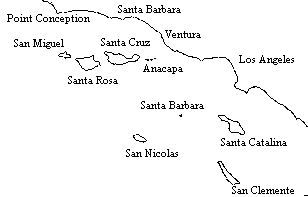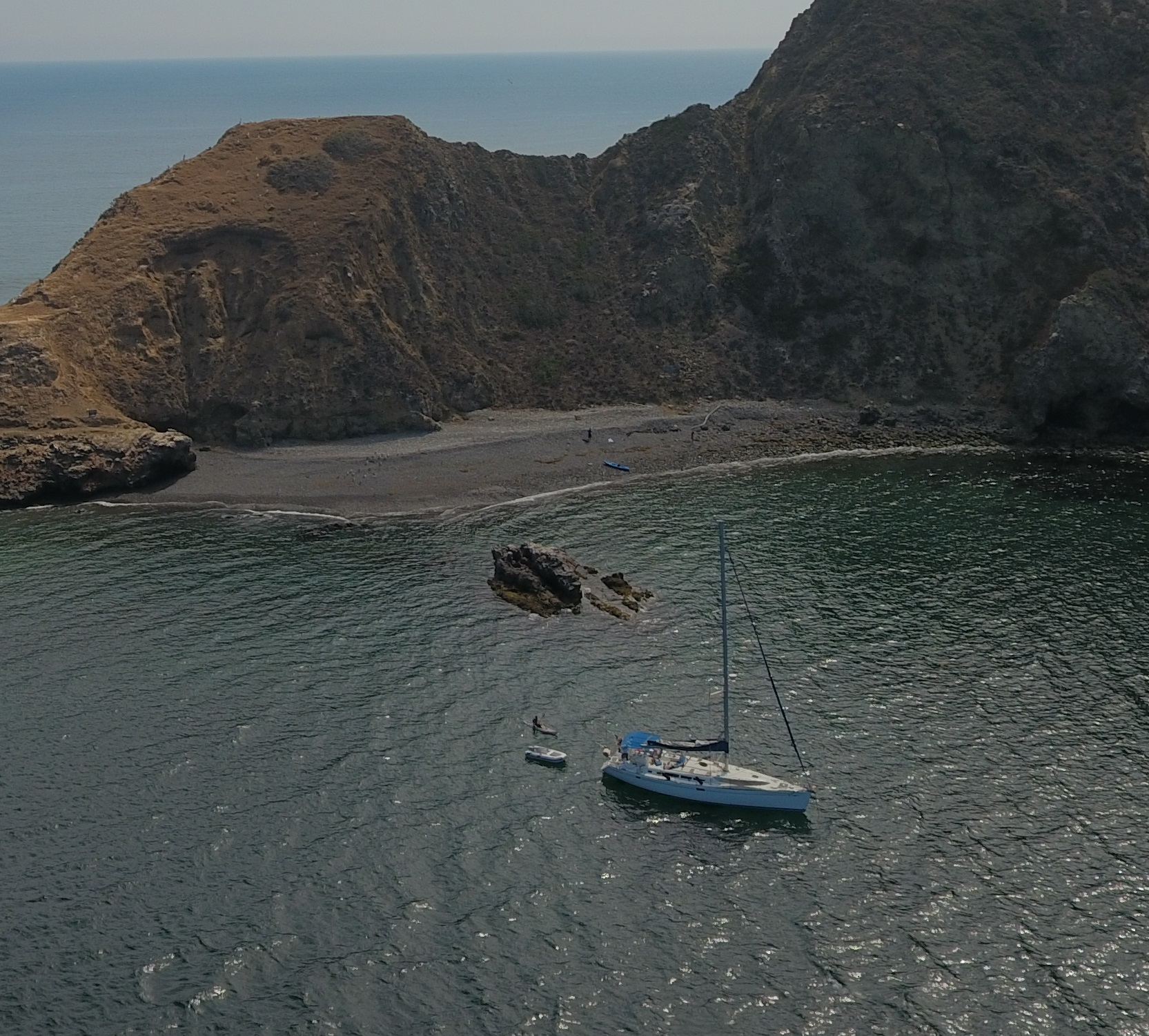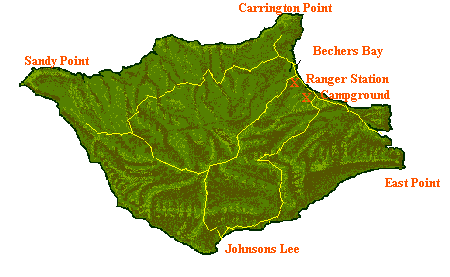For informational purposes only. Sailing Club.
Channel Island National Park Comprising of five of the eight California Channel Islands, Channel Islands National Park is home to a wide variety of nationally and internationally significant natural and cultural resources. Over 2,000 species of plants and animals can be found within the park. However only four mammals are endemic to the islands. One hundred and forty-five of these species are unique to the islands and found nowhere else in the world. <br> Marine life ranges from microscopic plankton to the endangered blue whale, the largest animal to live on earth. Archeological and cultural resources span a period of more than 10,000 years. The park consists of 249,353 acres, half of which are under the ocean, and include the islands of San Miguel, Santa Rosa, Santa Cruz, Anacapa, and Santa Barbara. Even though
the islands seem tantalizingly close to the densely populated, southern California coast, their isolation has left them relatively undeveloped, making them an exciting place
for visitors to explore.
- VISITATION:
- Annual visitation to the park’s mainland visitor center is 300,000. Visitation to the islands and waters is low, with about 30,000 visitors traveling to the islands, and another 60,000 who go only into park waters. Although most visitation occurs in the summer, migrating gray whales and spectacular wildflower displays attract visitors in the winter and spring. Autumn is an excellent time to travel to the park, as well as for diving, as the days are usually sunny, with minimal winds and clear ocean water.
- LOCATION:
- The islands within the park extend along the southern California coast from Point Conception near Santa Barbara to just north of Los Angeles. Park headquarters
and the Robert J. Lagomarsino visitor center are located in the city of Ventura. 
- CLIMATE, RECOMMENDED CLOTHING:
- Climate is mild, with little variation in temperature year round. However, be prepared for high winds, fog, and sea spray at any time. Visitors to the islands should dress in layers, with short and long pants, windbreaker, hat, sunscreen, and waterproof outer clothing. Wear sturdy hiking shoes with non-slip soles.
 Anacapa Island:
Anacapa Island:- (699 acres) Anacapa has hiking trails, a visitor center, lighthouse exhibits, primitive campground, and picnic area and offers opportunities for SCUBA diving, snorkeling, bird watching, fishing , and observing marine mammals.
- Frenchy’s Cove Anacapa

 Santa Barbara Island:
Santa Barbara Island:- (639 acres) Santa Barbara has hiking trails, a visitor center, picnic area, and primitive campground and offers opportunities for hiking, bird watching, SCUBA diving, snorkeling, fishing, and marine-mammal observation.
 San Miguel Island:
San Miguel Island:- (9,325 acres) San Miguel has a primitive campground, miles of hiking trails, and beaches and offers Ranger-led hikes, marine-mammal observation, beach exploration, and bird watching.
 Santa Rosa Island:
Santa Rosa Island:- (52,794 acres) Santa Rosa has hiking trails and a primitive campground and offers beach exploration, wildlife observation, ranger-led hikes, vehicle tours,
and kayak beach- camping.  Santa Cruz Island:
Santa Cruz Island:- (60,645 acres) 76 percent of Santa Cruz Island is owned by the Nature Conservancy. The National Park Service owns the eastern 24 percent, where visitors
may observe wildlife, hike, camp and explore the newest addition to the park. - Marine Resources:
- (125,000 acres) Extending 1 mile from the islands’ shoreline the park’s waters offer a full range of activities including sailing, power boating, fishing, SCUBA
diving/snorkeling, surfing, wildlife observation and bird watching. - Accessibility:
- The mainland visitor center is fully accessible. Due to their isolation and transportation requirements, the islands are not readily accessible for individuals in
wheelchairs or those with limited mobility. Efforts are underway to provide some wheelchair accessible areas on Santa Rosa Island via air transportation.
Please call the park for information. - RECOMMENDED ACTIVITIES/PARK USE:
- Visitors to the park may enjoy a variety of recreational opportunities, such as SCUBA diving, snorkeling, swimming, bird watching, kayaking, whale watching,
and sailing. On the islands, one may camp, hike, picnic, and explore tide pools, isolated beaches, and rugged canyons. Park naturalists conduct interpretive hikes
on the islands throughout the year. - BASIC VISIT RECOMMENDATIONS:
- Inform yourself about the park, its features, and safety concerns before visiting, by contacting the park for brochures, and the boat and air concessions for
- schedules. Because of the time involved in traveling from the mainland to the islands, a full day is recommended to visit the park. Anacapa is a great island for your
first visit; it is the closest island to the mainland (1 � hour boat ride) and consists of dramatic, steep cliffs, with hundreds of sea birds and marine mammals. Snorkeling,
kayaking, and diving are all excellent in the rich kelp beds around Anacapa. - For a multi-day visit, Santa Rosa is a good destination. Rangers will take you to various parts of the island to explore canyons and beaches.
- For a feel of a wilderness experience, San Miguel, the furthest out from the mainland, may be your choice. The island often is fog-covered or very windy. Access to
many areas on the island is limited due to fragility of the terrestrial and marine resources. - The islands have no stores, restaurants, or overnight accommodations; you must bring all your own food, water, and camping equipment.
- VISITOR IMPACTS:
- The introduction of alien plant and animal species, which do not naturally occur in the park, is the biggest human impact on the islands. Alien species often
negatively impact the native plants or animals, sometimes endangering their survival. Visitors should take care to not bring in seeds of plants on clothing or shoes. - Over-fishing of the marine resources is another harmful human impact. Studies are being conducted at the park to determine species that may be in jeopardy due to
over-use, and the usefulness of restoration efforts. Human use of tide pools, beaches, and other areas may inadvertently disturb some endangered species, including the
California brown pelican, or seals and sea lions. These animals are protected by federal law; please stay far enough away from these animals so to not disturb them. - Illegal collection of cultural artifacts is also another negative human impact. Any artifacts found should always be left where they were seen and reported to the Park
Service, since disturbance can ruin the archeological record and the educational value of these finds.
Email: Reservations@channelislandscharter.com
Phone: 424 781-7245


